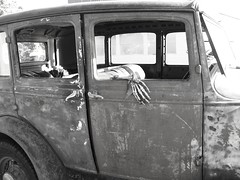Skeletons. In real life, even the unmoving kind would likely make almost everyone likely to see this blog lose his lunch. If I ever saw one actually dancing around, or God forbid trying to claw my face off, I'd probably shit myself, pop a gasket, and go screaming and crying in a fit of temporary insanity. And I like to think I'm a decently brave guy.
 |
| Apparently Spielberg used real skeletons in Poltergeist. Yeah, I'd be making that face too, and you wouldn't even have to pay me. |
There have been various antidotes tried. Flaming skeletons, icy skeletons, electric skeletons, big skeletons, bloodthirsty skeletons, etc. etc. ad nauseam. My basic problem with all of these is that they're simply different monsters. They're not just skeletons; they're dire skeletons of some variety. Some of them are really cool (like the Eye of Fear and Flame) but they're not just skeletons. They're 'skeletons and'.
 |
| The uncommon and elusive 'drunk driving skeleton', which despite its rarity is responsible for an unrepresentatively large number of adventurer deaths. |
The formula is simple. Skeletonization is contagious. Roughly every 1 in 30 skeletons (or 1 in 20, or 1 in 10, or whatever makes you happy) will, if it touches you with its bare claws or with anything it's holding, cause your skeleton to animate, rip out of your body in an extremely gruesome manner, and start attacking the rest of the party. Save vs. death every time it hits you. Oh, and did I mention that your newly animated skeleton is a carrier for the contagion?
Needless to say, the poor sod this happens to is very, very dead. Though I suppose if his friends like him far too much for their own good and they're extremely clever, they might find a way to subdue his skeleton, collect his meatsack remains, and convince a cleric to both remove the curse (with Remove Curse and Cure Disease, naturally) from the skeleton and resurrect him.
If you're playing GURPS, you can treat it like an Eviscerate spell cast at 21. If it were me, I'd make it Will to resist instead of HT.
That oughtta make your players take skeletons seriously next time they see a gaggle hanging around some wannabe lich.

In my previous campaign, we called this "Skeletonosis."
ReplyDeleteHi Jovus! Hope you and the missus are doing well.
ReplyDeleteI have in the past let my players encounter undead skeletons surrounded by the still living flesh of their previous owners. However, the skeleton did not rip its way out - it used the living flesh as a "meatshield."
I believe that this did, indeed, actually creep them out.
Hi Martin! Sorry about not seeing your comment earlier. We're doing plenty fine, though of course we miss our friends from Madison.
Delete